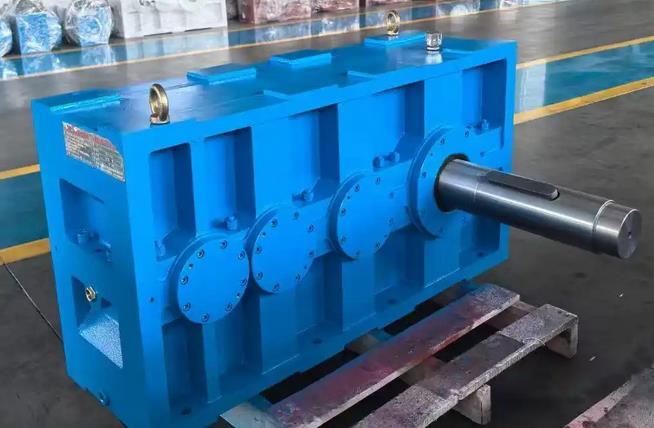Attention to details when installing ZLYJ315 reducer for screw extruder to ensure normal operation
When installing ZLYJ315-14-VI reducer for rubber screw extruder, the following are some details to pay attention to:
Installation foundation:
The reducer should be installed on a flat foundation, which should be firm and able to withstand the load and vibration of the reducer during operation, to avoid abnormal vibration or damage to the reducer caused by uneven or unstable foundation.

When fixing the reducer with anchor bolts, it is necessary to ensure that the anchor bolts are evenly tightened. After tightening the anchor bolts, ensure that the screw inserted into the output shaft can rotate uniformly without jamming, to prevent additional stress on the output shaft bearing and affect its life. It is strictly prohibited to use strong installation and removal of screws.
Connection method:
If a coupling is used to connect the power input, only the coupling is allowed to input power for reducers with specifications of 420 and above. During installation, it is necessary to ensure that the installation error of the coupling does not exceed the allowable range while the foundation screws are tightened. It is not allowed to center the coupling first and then tighten the foundation screws without leveling the foundation support, in order to avoid causing excessive additional torque to the input shaft.
For reducers with specifications of 375 and below, it is allowed to use V-belts for power input. High strength narrow V-belts should be used as much as possible, and all V-belt wheels should be machined and balanced by turning. When the triangle belt is initially installed, the midpoint of the tight edge can deform by 8-10mm under an external force of 2-3 kilograms. Pay attention to the tension of the V-belt. If the tension is too high, it will increase the load on the input shaft and bearings, while if it is too low, it will cause the belt to slip.
Concentricity adjustment:
During installation, it is necessary to ensure that the output shaft of the reducer is concentric with the screw shaft of the rubber screw extruder, and that the input shaft of the reducer is concentric with the output shaft of the drive motor. The deviation of concentricity can cause additional stress and vibration in the gearbox during operation, accelerate the wear of gears and bearings, and even lead to equipment failure. Professional measuring tools such as dial indicators can be used to detect and adjust concentricity, ensuring that its deviation is within the specified range.
Cleaning and rust prevention:
Before installation, the gearbox needs to be thoroughly cleaned to remove internal debris, oil stains, etc., to prevent these impurities from entering the gears and bearings during operation, causing wear or blockage of the oil circuit. At the same time, apply anti rust oil to the exposed machined surface of the reducer to prevent rusting.
Lubrication system:
Select the appropriate viscosity lubricating oil according to the data shown on the gearbox nameplate. After the installation of the gearbox is completed, fill the lubricating oil to the oil level indicated on the oil gauge. The oil level should be determined after the lubricating oil is evenly distributed in the tank. The oil level should be checked regularly, and in any case, the oil level should not be lower than the lower oil mark position.
After the first 300-600 hours of use, the oil should be changed once, and then every 3000 hours thereafter. The replacement should be carried out when the reducer is stopped and the lubricating oil has not yet cooled down. The box should be washed clean with the same quality of oil. If it is not suitable to wash due to high viscosity, it can be heated first.
A reducer equipped with an oil pump for forced lubrication may experience insufficient oil intake and excessive noise during the initial driving stage due to high oil viscosity and high oil pump suction resistance. This usually disappears on its own after the lubricating oil temperature rises. During normal operation, if there is an increase in oil pump noise, it may be due to excessive resistance in the oil circuit. At this time, the filter and its related components need to be cleaned.
Rotation direction:
Some ZLYJ reducers are equipped with a one-way oil pump on the high-speed shaft, and the default rotation direction is clockwise facing the thrust package (i.e. configured as a right-handed screw). If it is a left-hand screw or requires a change in rotation direction, it should be specified when ordering so that the manufacturer can configure it accordingly or the user can take the correct measures during installation.
Work environment:
The working environment temperature of the reducer is generally -10 ℃ -50 ℃, with humidity ≤ 85%. It should be installed in a well ventilated place without corrosive, explosive gases or steam to ensure the normal operation and service life of the reducer.
Security protection:
After installation, safety protection measures such as protective covers should be set up

